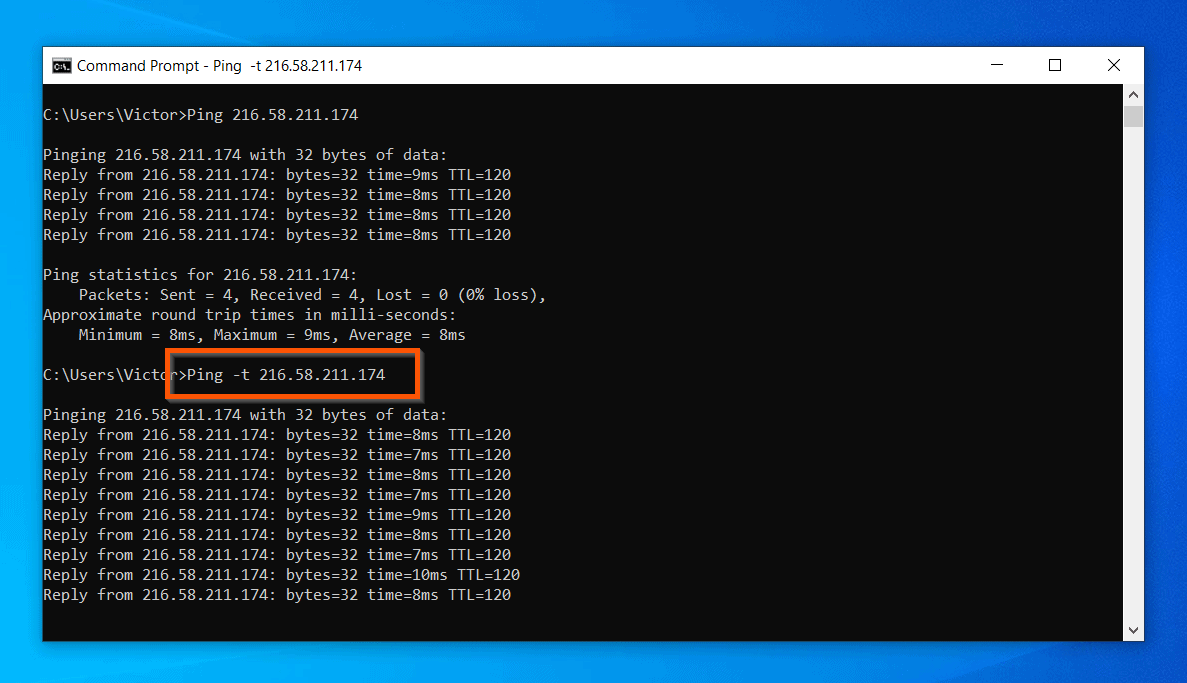
Ping Command Full Network Route
Command adding up with the basic ping command using some metacharacters./prettyping whatever.host.you.want.to.ping4. Related macOS commands: netstat - show network status.The Net Send commands replacement application gives PC and Mac users an ability. Ping example.com, printing the full network route ECHOREQUEST sent and ECHOREPLY received: ping -R example.com 'Theres a Nong Nang Ning, Where the trees go Ping' Spike Milligan. Ping example.com, giving an audible beep when the peer is reachable: ping -a example.com.
/ping-command-prompt-92f4acb37dfc4bbc9ac1ae6d99faaa45.png)
Detects missing/lost packets and marks them at the output. Eg ping -c 5 10.10.10.1Check out the prettyping repository on GitHub. Stopping a Ping in Windows
Sane defaults, auto-detects terminal width, auto-detects if the output is a terminal. No installation required, just run the script from anywhere (and make sure you have the 3 dependencies, most Linux distros already have them). Fast startup, very few and lightweight dependencies. Detects repeated messages and avoids printing them repeatedly. Correctly handles “unknown” lines, such as error messages, without messing up the output. Two sets of statistics are calculated: one for the most recent 60 responses, and another for all responses since the start of the script.
Root access is NOT required. As a wrapper, it can run as normal user. As a wrapper, you can use the most common ping parameters in prettyping as well. Options not recognized by prettyping are passed to the ping tool.
Ping Command Plus A Non
Configure your terminal correctly, switch to another terminal, or just use the -nounicode option. Graphical output of the latency using unicode characters (can be disabled by command-line option).Animated GIF (sped up to 4×) showing what prettyping can do:Very old screenshot, showing how prettyping looked like in 2008:Medium (C compiler + ncurses + root privileges)Precise individual values are printed, average is only printed upon exitStatistics for each host are updated on each response, plus a non-intuitive legend for the graphNoping: Enhances the normal output with colors and live statistics and prettyping-inspired graphicsStatistics for each host are updated on each response, plus an intuitive and colorful graphHard (lost packages aren’t printed on the Linux ping)Easy ( ? at the graphic, plus listed in the statistics)Very easy ( oping prints missing responses, noping additionally shows them in the graph)Very easy (red ! at the graphic, plus listed in the statistics)Updated in real-time, considers all responses since the beginning of the runNoping: Updated in real-time, considers all responses since the beginning of the runUpdated in real-time, shows statistics for all responses since the beginning of the run, as well as statistics for the most recent 60 responsesStandard output with optional colors and VT100 escapesAdapts to the terminal size (only the future responses, the past responses are not changed)I don’t see the block characters, all I see are weird characters such as “â.”.Your terminal does not seem to support UTF-8. Colorful output (can be disabled by command-line option). In such mode, prettyping will avoid using cursor-control escape codes.
Finally, the statistics of the run are only printed at the very end, after ping finishes running. Not just that, but missing/lost packets are not reported at all. However, the standard ping output is too verbose, making it hard to have a quick glance at latency. I noticed that, very often, we were looking at the output of the ping tool to measure the quality of network links, by looking at a combination of packet loss ratio and latency. A bit of historyPrettyping was originally written in January of 2008, while I was working at Vialink.




 0 kommentar(er)
0 kommentar(er)
